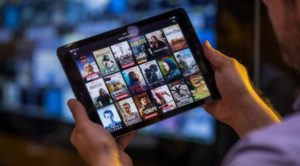Exclusives

The Eternal Search for the Next Movie
Story Highlights
Nineteen-year-old UCLA law student Alan Shimp shares how COVID-19 has emphasized the importance of intelligent content recommendations.
One personal consequence of the COVID-19 pandemic is that I had to temporarily evacuate my awesome L.A. apartment to move back with my parents in a virus-free remote location. There, to my dismay, they continue to watch the same movies and TV shows that they’ve been watching for 40 years.
To be fair, Dirty Dancing (1987) is a fine movie, but how many times can you watch it? They claim it’s just too difficult to find something new and they have a point. Ineffective movie recommendation engines have created an enormous productivity problem, but I believe there is a better way.
It’s now a crisis
Today, a massive amount of content can be accessed nearly anywhere and anytime, on a multitude of different screens. The average American watches roughly four hours of movies or television each day, and they spend another hour looking for something to watch. Ericsson, in its TV and Media report, called this a “Content Discovery Crisis,” and predicted that the problem would only get worse. Indeed, spending seven hours per week — the equivalent of 15 full days per year — looking for something to watch is alarming.
Ironically, as more options become available, the problem becomes worse. Nielsen estimates that there are now 646,152 unique program titles available, and still it seems like there’s nothing on.
The problem is a “paradox of choice.” Making a binary decision is relatively simple.
For example, it’s easy to decide if you would you rather watch The Seventh Seal (1957) or Frozen II (2019), but given nearly 650,000 options, it’s almost impossible to sort through them without guidance. Further, viewers are more likely to regret a choice made from many options, because they can’t consider every option and suspect there might have been something better.
What to watch
This brings us to the challenge of creating a video recommendation engine. All the streaming services have one, but clearly, they’re not very effective. Otherwise, viewers wouldn’t be engaged in hours of searching.
So why are video recommendation engines so ineffective?
The concept of video recommendations grew out of the science of market research, but the two have substantially different goals. Market research has its origins in the 1920s as a way of establishing who, if anyone, was listening to the radio. Using market research, advertisers gained insight into the tastes and demographics of listeners. That idea remains useful for targeted advertising and even drawing subscribers to subscription platforms, but it doesn’t help an individual viewer pick something to watch in the moment.
Market research works on the premise that people in one demographic are more receptive to certain marketing messages than people in another demographic.
“When people say that they `want to see a movie like _____,’ what exactly does that mean? After years of these conversations with people who expect me, as a film historian, to know the precise answer to this question, I’ve found that question is really a placeholder. I think people really want to see a film that will give them the same emotional satisfactions as the movie they’ve just seen – and not every movie of the same genre, or a remake, or a sequel, or a movie with the star, is going to provide these same satisfactions.” – Dr. Kevin Hagopian, Professor of Film Studies at Penn State University
For example, 25-year-old women are more likely to buy lipstick than 60-year-old men. They’re also more likely to watch The Gilmore Girls (2000–2007). So, if you’re selling lipstick, advertising on The Gilmore Girls makes sense. However, in the 21st century, programmers developing recommendation engines were less judgmental and cast aside the demographics. If a 60-year-old man is watching The Gilmore Girls, he might also like lipstick. So instead, programmers used machine learning (a subdiscipline of artificial intelligence) to identify “similar users.”
Their solution didn’t rely on viewers’ ages, addresses, or any other demographic information. They simply looked for patterns of behavior. People who buy coffee also buy coffee filters regardless of their demographic. Further, they also do it on a recurring basis. If you want to market coffee filters, target people who buy coffee. Of course, that’s obviously a simplistic example. The goal of machine learning is to look at similar users to find less intuitive connections. Perhaps people who buy coffee also buy watermelons.
 It might follow that if someone watched three movies and a second person watched two of the same movies, that second person might also be interested in the third movie.
It might follow that if someone watched three movies and a second person watched two of the same movies, that second person might also be interested in the third movie.
However, this at best uses inductive reasoning to come to a likely conclusion rather than a certain one, and it isn’t even very good inductive reasoning.
It starts with the assumption that there is a discernable pattern in the video selection of those two people, and then attempts to describe an algorithm which matches that pattern.
In this case, more data (more users) should lead to a more accurate prediction, but what if the underlying assumption is wrong?
If there is no pattern, more data isn’t helpful at all. It’s like picking winning lottery numbers. Even if you could find some extraordinarily complicated algorithm to explain the last 50 years of winning numbers, you still wouldn’t be able to pick tomorrow’s numbers. Past performance is no guarantee of future results.
There are so many variables that go into choosing something to watch that it’s functionally random, and no algorithm created this way could accurately predict the next best film to watch.
A better way
However, if a platform wanted to focus on creating a great customer experience through the effective use of its full library, there is a way to create a recommendation engine that would produce satisfying results. While viewers won’t typically say, “I want to watch something that someone with similar viewing habits is watching” they very well might say, “I want to watch something similar to another great movie I recently watched.”
This is part of the roller coaster theory of psychology. If you just had a terrific roller coaster ride, you want to either get right back on or find a coaster that’s even longer or faster. Similarly, film watchers either re-watch a favorite movie (like my parents watching Dirty Dancing) or look for a similar one that’s even better.
 To create an effective recommendation engine, it’s necessary to find a relationship between the movies or television shows themselves. When you get off the coaster, don’t look for the longest line, look for the next coaster.
To create an effective recommendation engine, it’s necessary to find a relationship between the movies or television shows themselves. When you get off the coaster, don’t look for the longest line, look for the next coaster.
The longest line might be for the restroom. It’s therefore necessary to compare content to other content instead of viewers to other viewers.
For example, suppose you wanted to see a movie like Disney’s Cinderella (1950). Which of the following would you choose? Citizen Kane (1941), Sleeping Beauty (1959), Dirty Harry (1972), or Risky Business (1983)?
The answer seems obvious, but the real question is whether machine learning could come to that same conclusion. If so, can machine learning spot films that are similar in less obvious ways?
It’s like finding a connection between coffee and watermelons. It can be done, but the film experience is complex and subjective. It isn’t as simple as categorizing content by screen credits or genre. The Searchers (1956), Blazing Saddles (1974), and Cowboys & Aliens (2011) are all Westerns but they have little else in common. Daniel Craig was in Cowboys & Aliens, but he was also in Knives Out (2019), and those films have nothing else in common either – or do they?
“Discovery leads to engagement. Engagement leads to value. Value leads to loyalty (to the service/platform). No matter how good an AI-driven algo is, the recommendation will never beat a viewer’s mind. So, why not deliver a great user experience by providing a robust search tool? Discovery can happen in the form of search, as well as recommendations. The platforms each offer their own flavors of AI recommendations. Then there is browsing, which is more of scrolling through the recommendations. Then finally search — give the user the proper tool to conduct his/her own search!” – Jonathan Chen, Senior Director of Media Industry Solutions at SAP
If the right metrics could be analyzed to determine film similarity, this could improve not only the recommendation function, but also the search function. A viewer could look not just for the films that are most similar, but for films sharing the actual specific attributes.
To return to the grocery store analogy, suppose you eat a different kind of sandwich every day. Then suppose, looking back, you discover that all of those sandwiches had ham on them. You now know that you like sandwiches, and that you like ham. Maybe the one sandwich you didn’t like had salami on it. Effectively, you’re creating personal filters that allow you to narrow the total field of possible sandwiches, or even possible meals, to ones which you can be confident you’ll enjoy.
Ideally, viewers could do the same with their streaming content, supplementing automatic recommendations with self-analysis of their own tastes.
 Machine learning could describe to what extent (by percentage), and in what ways, two films are similar.
Machine learning could describe to what extent (by percentage), and in what ways, two films are similar.
However, in order to compare two film or television titles, the computer must be able to observe and quantify the principles of film theory and aesthetics. I believe there are basic principles of story structure and philosophy dating back to the beginnings of human civilization that can be discovered and used by machines to do exactly that.
For more specific information on how this can be accomplished, take a look at my the SlideShare presentation here and, if you like what you see, please leave me a comment.
Also, if you know any movies that are similar to Dirty Dancing, my parents could use a good recommendation.
Alan Shimp is a 19-year-old, third-year law student at UCLA earning a certificate in entertainment law who would love nothing more than to work in business and legal affairs in the media and entertainment industry. He’s co-author of The Film Fan Handbook series. Connect with him on LinkedIn.









